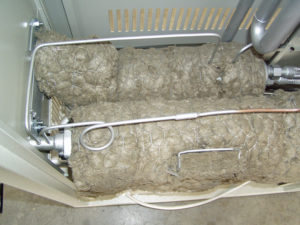Insulation and auto-ignition temperature
Insulating materials capable of absorbing possible oil leaks and overflowing are to be avoided in diathermic oil thermoregulating units. Instead, it’s better for leaks to be free to drain in collecting tanks. In fact, it is better to not have insulation at all. If high temperature oil gets in the pores of the insulating material, an oxidation process gets triggered, bringing further heat to what’s already present in the insulating material thus increasing oil’s temperature. When the diathermic oil surpasses its autoignition temperature, the risk is to immediately have fires.
In diathermic oils, the flash point and the fire point are respectively the lowest temperature at which its vapors ignite when an ignition source is given, or keep burning even after the ignition source is removed. The autoignition temperature is the temperature value at which a thermal transfer fluid ignites spontaneously in contact with air, without any other ignition source.
In addition, the expansion vessel in units with open vessel must be installed at a security distance from the operating pipes (or otherwise the connection pipe must be carefully cooled). The aim is to ensure the oil within the vessel remain at temperature under 65/70° C. It will avoid oxidation effects in contact with air and oil cracking, which will cause the loss of the oil characteristics resulting in possible obstruction of the plant.
COOLING
Mixed cooling systems are suitable, in order to boost the reliability of particularly demanding cooling cycles.
AIR DISCHARGE IN THERMOREGULATING UNITS
Finally, in order to ensure the proper long term reliable operations of a diathermic oil thermoregulating unit, it’s crucial to make sure there is no air bubbles within the oil circuit at high temperature. The presence or air bubbles can cause cavitation that damages pumps and other components of the plant, and furthermore a very bad temperature regulation. Before a diathermic oil unit enters its full operating status, during its start-up it is suitable to carry out several air discharge cycles, making the circulating pump spin freely, while increasing the temperature up to 100° C and keep going on with free cycles increasing the temperature step by step, until there is no more air within the plant. In several years of experience in field applications, the 90% of issues during the start-up phase of diathermic oil thermoregulating units are related to a wrong air discharge procedure management.




 Back to index
Back to index Download the complete book
Download the complete book